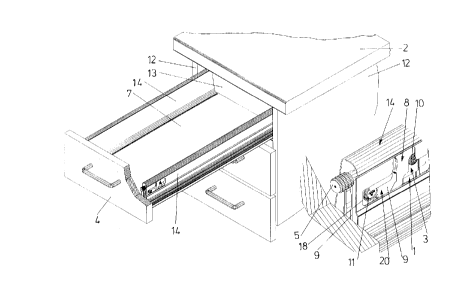Note : Les revendications sont présentées dans la langue officielle dans laquelle elles ont été soumises.
Claims
1. A device for attaching the front panel (4) of a drawer to side walls (14) of a drawer,
with a holding part (9) secured to the front panel (4) and a support part (3) secured
to a drawer side wall (14) on each side of the drawer which can be coupled with
each other, whereby a rocker element (8) is mounted in the support part (3) withwhich the holding part (9) is engageable, a spring (6), preferably a pressure spring
and a helical spring which is mounted on a shank (21) which is suspended in the
support part (3), acting on the rocker element (8) in such a way, that when the front
panel (4) is mounted, limited relative movement of the holding part (9) with respect
to the support part (3) against the action of the spring is possible, characterised in
that the rocker element (8) is mounted on the support part (3) without an axle
whereby the shank (21) is provided on the rocker element (8) and the rocker
element (8) is mounted on the support part (3) by means of the shank (21) whereby
the spring (6) which struts the support part (3) pushes or pulls the rocker element
(8) in the direction to the rear end of the drawer side wall (14) pressing on stops
(24) which are provided at the free end of the shank (21).
2. A device as claimed in claim 1, characterised in that the spring (6) is a pressure
spring and a helical spring which is mounted on the shank (21) and which presseson stops (24) arranged at the sides of the free end of the shank (21):
3. A device as claimed in claim 1, characterised in that the shank (21) with the rocker
element (8) is punched out of sheet steel and that the shank (21) projects through
a slot (22) in a web (23) of the support part (3).
4. A device as claimed in one of claims 1 to 3, characterised in that the rockerelement (8) is provided with two hooks (25,26) one of which detaining the holding
part (9) pushed into the support part (3), while the other is constructed as a stop for
the holding part (9) in the region of the support part (3).
5. A device as claimed in claim 4, characterised in that the hook (25) which is
constructed as a stop, projects into a slot (32) provided in a horizontal guide web
(30) of the support part (3) when the holding part (9) is released.
6. A device as claimed in claim 4, characterised in that the hook (25) which isconstructed as a stop is provided with an oblique mating edge (40) for the holding
part (9).
7. A device as claimed in one of claims 1 to 6, characterised in that the rocker
element (8) is provided with a hole (28) for the insertion of a screw driver forcross-slotted screws or the like and that on the support part (3) a rack profile (37) is
provided, which is aligned perpendicularly to the front panel (4), and with which the
screw driver (16) for cross slotted screws meshes.
8. A device as claimed in claim 7, characterised in that the rack profile (37) constitutes
the border of a slot (36) the width of which corresponding approximately to the
diameter of the hole (28) in the rocker element (8).
9. A device as claimed in claim 7 or 8, characterised in that the rack profile (37) is
provided with a curved portion at its end which is directed to the front panel (4).
10. A device as claimed in one of claims 1 to 9, characterised in that the rocket
element (8) is provided with a stop (27) directed towards the front panel (4) and
which abuts the support part (3) when a pulling force acts on the front panel (4)
detained by the rocker elements (8).
11. A device as claimed in claim 4, characterised in that the hooks (24, 26) are directed towards each other.
12. A device as claimed in one of claims 1 to 11, characterised in that the support part
(3) is provided with two horizontal webs (29, 30) between which the holding part (9)
is insertable and that one of the webs (29) is provided with a slot (33) which is open
to the rear into which the rocker member (8) projects, the borders of the slot
providing a lateral guide for the rocker member (8).
13. A device as claimed in one of claims 1 to 12, characterised in that the shank (21)
of the rocker member (8) is provided with a bend.
